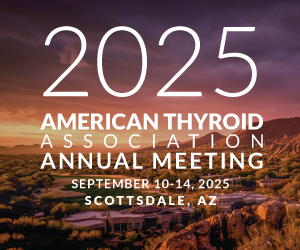
Hyperthyroidism Awareness: Understanding the diagnosis and all treatment options
Sarah Oltmann, MD
University of Texas Southwestern, Dallas, TX
November 16, 2020
November marks hyperthyroidism awareness month, so what a fitting topic to discuss for our Thyroid Health Blog!
It is important to remember that hyperthyroidism can occur at any age. While most may present with a rather typical constellation of symptoms, many may present with exacerbation of pre-existing conditions which may make the diagnosis initially elusive. Worsening anxiety, insomnia, fatigue, panic attacks, palpitations, hypertension or diarrhea may not initially signal that the thyroid is involved. Clinicians must have a low threshold to check thyroid function early to rule out a component of hyperthyroidism.
Once a suppressed thyrotropin (TSH) has been detected, further investigation with serum triiodothyronine (T3) and free thyroxine (free T4) can help delineate overt from subclinical disease. A thorough history of past thyroid disease, as well as current medications and supplements, can help detect any pre-existing diagnoses or exogenous sources of thyroid hormone or over supplementation with iodine. More commonly, hyperthyroidism is due to either Graves disease, toxic multinodular goiter or toxic adenoma. Distinction between these can usually be made with the assistance of a thyroid uptake scan, TSH receptor antibody measurement, and thyroid ultrasound. An additional physical exam finding of exophthalmos can further support the diagnosis of Graves’ disease. Understanding the etiology can help guide patient expectations. A small percentage of patients with Graves’ Disease may undergo spontaneous remission after 1 to 2 years, which may prompt patients to wait before considering a definitive treatment option.
With confirmation of the diagnosis of hyperthyroidism, focus is on hormonal control with an antithyroid medication (ATM, most commonly Methimazole in the United States). This may be augmented with beta-blockade, steroids, cholestyramine or SSKI for those who are difficult to control.
Many patients may need further consideration for definitive management with either radioactive iodine ablation (RAI) or thyroidectomy. Your local resources may also influence these options, but it is critical to understand that all three treatments (ATM, RAI and thyroidectomy) are possible options. Certain patient factors and priorities may alter the preferred definitive treatment. Smaller gland size, easy to control hormones, and lack of eye symptoms are factors that may favor continued ATM management. A large goiter with compressive symptoms, difficult to control hormones requiring high dose medications/ multiple modalities, pregnancy, severe eye disease, multiple nodules within the thyroid with or without thyroid cancer, or desire for rapid and reliable hormone control may favor thyroidectomy. RAI is a good option for patients with a smaller gland size, and a desire to pursue definitive management but avoid surgery.
There are also relative contraindications for treatment options. ATMs may have serious side effects, like agranulocytosis or liver failure, which prevent further use, or may cause skin eruptions making long term use intolerable. Additionally, high dose requirements or fluctuating doses may make long term use of ATMs not reliable. Women who are pregnant, wanting to become pregnant in the next 6 months to 1 year, breast feeding or have small children in the home will want to avoid RAI. Patients with severe eye involvement, have a large goiter with compressive symptoms, or are smokers should also avoid RAI. Thyroidectomy will be a poor option for patients with multiple previous neck operations on or around the thyroid due to internal scarring, or who are high risk for general anesthesia. Additionally, if they have a history of previous gastric bypass surgery, they are higher risk for major complications from hypocalcemia/hypoparathyroidism after thyroidectomy.
To help the patient navigate these decisions, it is important to allow them the opportunity to discuss each treatment option with respective physician experts – medical management with endocrinology, RAI with endocrinology and potentially nuclear medicine as well, and thyroidectomy with the thyroid surgeon.
In summary, patients with hyperthyroidism require medical control, as well as a clear understanding of the etiology of their hyperthyroidism. Patients with Graves disease, toxic multinodular goiter and toxic adenoma have more than one treatment option, and it is important for patients to be educated and engaged in treatment decisions.
For Further Reference:
American Thyroid Association Guidelines for Diagnosis and Management of Hyperthyroidism and other causes of Thyrotoxicosis| by the American Thyroid Association
Disclaimer:
The ideas and opinions expressed on the ATA Blogs do not necessarily reflect those of the ATA. None of the information posted is intended as medical, legal, or business advice, or advice about reimbursement for health care services. The mention of any product, service, company, therapy or physician practice does not constitute an endorsement of any kind by ATA. ATA assumes no responsibility for any injury or damage to persons or property arising out of or related to any use of the material contained in, posted on, or linked to this site, or any errors or omissions.



